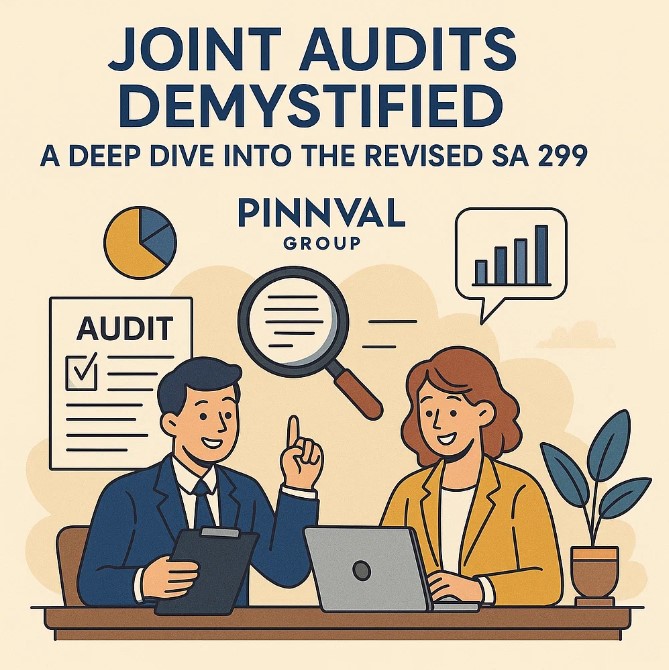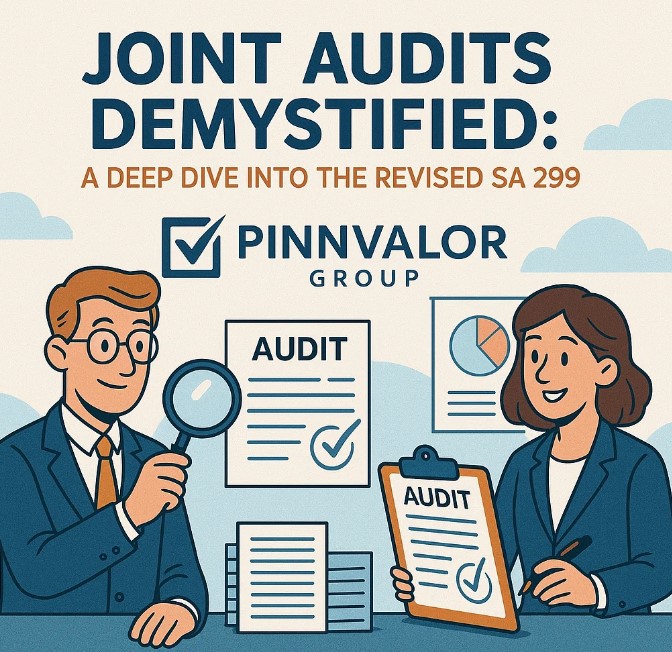
Joint Audits Demystified: A Deep Dive into the Revised SA 299
In today’s dynamic business environment, large and complex entities often require the expertise of more than one audit firm to effectively conduct statutory audits. This practice, known as joint auditing, offers a multi-dimensional assurance mechanism by combining the strengths of multiple auditors. The Revised Standard on Auditing (SA) 299, titled "Joint Audit of Financial Statements", provides comprehensive guidance on how joint audits should be planned, performed, and reported.
Are two heads really better than one when it comes to auditing financial statements?
Two firms, one opinion—joint audits demand collaboration, clarity, and commitment. The result? Stronger assurance and greater accountability.
In this blog, we’ll explore the revised SA 299 in detail, unpack its core provisions, and understand its implications for auditors and stakeholders.
What is a Joint Audit?
A joint audit involves two or more audit firms appointed to work together to audit the financial statements of an entity and issue a single audit report. Each auditor is jointly and severally responsible for the audit opinion expressed.
Objectives of a Joint Audit
- To ensure greater transparency and accuracy.
- To leverage the expertise of multiple audit firms.
- To enhance audit quality by encouraging mutual review and professional skepticism.
- To mitigate concentration risks in the audit industry.
Why the Revision of SA 299?
The original SA 299 was introduced with the objective of guiding auditors in a joint audit arrangement. However, the evolving complexities in business practices, increased regulatory expectations, and the growing emphasis on audit accountability necessitated a revision. The Revised SA 299, issued by the Institute of Chartered Accountants of India (ICAI), aims to:
- Clarify responsibilities of joint auditors.
- Provide detailed guidance on audit planning, execution, and reporting in joint audits.
- Standardize practices to improve audit efficiency and quality.
Key Provisions of the Revised SA 299
1. Scope and Applicability
The revised SA 299 applies when two or more auditors are appointed as joint auditors for an entity. It is not applicable where one auditor is appointed and engages another auditor as an assistant or sub-contractor.
2. Allocation of Audit Work
One of the cornerstones of a successful joint audit is the clear allocation of audit areas. Joint auditors should:
- Decide mutually on the division of audit work.
- Document the work allocation in the audit documentation.
- Ensure the division is equitable and considers the expertise and resources of each audit firm.
Typical allocation may be based on:
- Geographical locations (branches, units, factories).
- Functional areas (sales, purchases, taxation, etc.).
- Subsidiaries or divisions in case of a group audit.
3. Coordination and Communication
Joint auditors are required to:
- Hold joint planning meetings.
- Share significant findings with each other regularly.
- Coordinate on audit strategy, materiality levels, and risk assessments.
- Review each other's work in areas of overlap or significance.
4. Reporting Responsibilities
While audit work may be divided, the final audit report is a single, unified document issued jointly by all appointed auditors.
Each joint auditor is responsible for:
- The areas they have audited directly.
- The overall audit opinion, after considering findings and discussions with other auditors.
In case of disagreement on any matter:
- The report should clearly reflect the differing opinions if consensus cannot be reached.
- A separate opinion or qualified conclusion may be issued by the dissenting auditor, if necessary.
5. Documentation and Evidence
Each auditor must:
- Maintain adequate documentation of their audit procedures.
- Ensure audit evidence is sufficient and appropriate.
- Share documentation with other joint auditors as needed for review and consensus-building.
6. Responsibility in Case of Fraud or Material Misstatement
If one joint auditor identifies a fraud or material misstatement, they must:
- Communicate the issue to the other joint auditor(s).
- Evaluate whether the matter impacts the overall audit opinion.
- Ensure the issue is appropriately addressed in the audit report.

Joint auditors are expected to exercise professional skepticism throughout the audit and are jointly responsible for areas not specifically divided if those areas materially affect the financial statements.
Benefits of Joint Audits
- Enhanced audit quality through mutual review.
- Risk sharing and better coverage in large or geographically dispersed audits.
- Capacity building for smaller firms when paired with larger ones.
- Reduction in auditor concentration risk, supporting regulatory objectives.
Challenges in Joint Audits
- Coordination issues due to differing methodologies or firm cultures.
- Inconsistencies in documentation and review practices.
- Time and cost may increase due to overlapping work and meetings.
- Potential conflicts in case of disagreement on audit findings or reporting.
Best Practices for Effective Joint Audits
- Early and frequent communication among joint auditors.
- Clear work allocation and role definitions from the outset.
- Joint planning and review sessions to align on strategy and judgment areas.
- Use of technology for documentation sharing and audit trail tracking.
- Ethical conduct and mutual respect to resolve conflicts professionally.
Conclusion
The Revised SA 299 offers a robust framework for conducting joint audits in a manner that is both efficient and effective. As the corporate world continues to grow in complexity, joint audits, guided by the revised standard, offer a valuable mechanism to ensure audit quality, independence, and stakeholder confidence. For auditors, embracing the principles of SA 299 means not only adhering to professional standards but also contributing meaningfully to the integrity of financial reporting.
Are you a finance professional or auditor navigating the complexities of joint audits? Share your experiences or questions in the comments—we'd love to hear your perspective!
